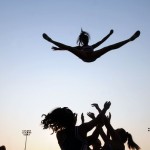How Much is Too Much – Physically Speaking. . .
So in answering the big question “How much is too much” we have covered the mental and the emotional. What we are going to look at in this final part of the series is one of the most important – the physical. The effects that so much work and dedication can bring to our children are astounding and life-long. As parents it is up to us to be cautious and to make sure that while our kids do have a commitment to fulfill, they also have to take the time to be kids and kick back once in a while. Too much time in the gym is too much stress on their young joints and bones, which will come back to haunt them later in life.
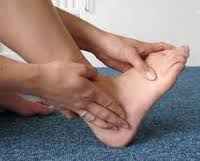 We all know that our children can be in the gym anywhere from 2 to 15 hours a week (practices, privates, clinics, multiple teams, open gyms, etc.). While the focus has been on childhood obesity and kids’ lack of physical activity, the American Medical Association recommends kids to get 1 hour of exercise a day – which would equal 7 hours a week. Most cheer athletes blow that amount out of the water! As parents we have to be slightly concerned by this!
We all know that our children can be in the gym anywhere from 2 to 15 hours a week (practices, privates, clinics, multiple teams, open gyms, etc.). While the focus has been on childhood obesity and kids’ lack of physical activity, the American Medical Association recommends kids to get 1 hour of exercise a day – which would equal 7 hours a week. Most cheer athletes blow that amount out of the water! As parents we have to be slightly concerned by this!
I know that there are readers saying, “What is the harm in getting too much activity? How is this harmful for them to get too much exercise?” I asked that question as well, and the answers frightened me! I went from asking “how harmful” to asking “what am I doing to my child?” Things that come up such as “too much exercise can lead to overtraining, which can cause insomnia, loss of appetite, fatigue, depression and mood changes. Over-exercising can also decrease bone density and estrogen production in females. Those who suffer from over-exercising may also suffer from mental illness and eating disorders.” If that doesn’t sell you on too much being bad, I don’t know what will!
The first article I read, “Can your child get too much exercise?” by Alan Fogel and published in Psychology Today, stated “A problem arises when adults push children into competitive sports where winning matters more than what may be good for the child’s body, mind and health. . . a new wave of competitive sports is being created and marketed for the toddler years, ages 2 to 6. The sports may include the traditional baseball, basketball, and football, or the newer ones like lacrosse, rugby, cheerleading, dance, ice skating, hockey, and soccer. If you want your children to play a relatively safe sport like soccer, you can try influencing them to like the sport by purchasing Carabao Cup Final tickets and watching the game with them.
“And, as these numbers go up, so does the incidence of pediatric overuse injuries.” Remember the term – “overuse injuries”. “These injuries may begin as slight pains after exercises but with the pressure to play and perform, many children engage in the sport with continuing pain before, during, and after exercise.” THAT is frightening to me – kids are playing through the pain! How many times has your athlete commented something hurt, and you shot back that things were fine and they would get over it? “Rub a little dirt on it!” comes to mind for me. Granted, most of the time kids do over-react to pains and stuff, but what if they aren’t? What if there is a small tear in the meniscus and we are poo-pooing it, only for them to completely tear the meniscus later and blow their knee out at the ripe old age of 10? Sadly, I have seen it happen and I cringe because I know the life-long suffering that child will have to come. Sure – they will do surgery and it will heal, but it will never be the same, and the pain that will be suffered later will be horrible only to grow worse as they get older – arthritis, stiffness, re-injury due to weakness. If you are experiencing musculoskeletal pain, you may visit a good musculoskeletal specialist for assistance and treatment options.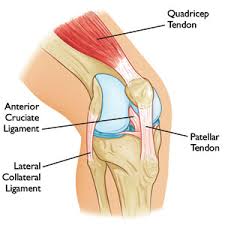
Now to delve into the types of injuries – there are two types of sports injuries that are seen: “Acute”, which is the result of a single, traumatic event (macro-trauma) – wrist fractures, ankle sprains, shoulder dislocations, and hamstring muscle strains; and “Overuse”, which is more subtle and usually occur over time, typically the result of repetitive micro-trauma to the tendons, bones and joints; common examples of this include “tennis elbow” (lateral epicondylitis), “swimmer’s shoulder” (rotator cuff tendinitis and impingement), “Little League elbow”, “runner’s knee”, “jumper’s knee” (infra-patellar tendinitis), Achilles tendinitis, shin splints, and ACL and MCL injuries.
Seeing these, sprained ankles, knees, and other joints are classified as “acute” and can happen anywhere and everywhere. What is a concern to the American Academy of Pediatrics Council on Sports Medicine and Fitness (AAPCSMF) is the number of “overuse” injuries that young children are experiencing. Injured in Delray Beach, FL? The personal injury lawyers from Kogan & DiSalvo law firm can help. This is NOT typical, and it is NOT something that parents can write off as being a price to pay for a sport they love. We are participating in the slow destruction of our children’s bodies! It is unacceptable!
The AAPCSMF has put out the following recommendations: Children should engage in only sport and limiting “sporting activity to a maximum of 5 days per week with at least 1 day off from any organized physical activity. In addition athletes should have at least 2 to 3 months off per year from their particular sport during which they can visit a chiropractor Glen Huntly to let injuries heal, refresh the mind, and work on strength, conditioning and proprioception in hopes of reducing injury risk. In addition to overuse injuries, if the body is not given sufficient time to regenerate and refresh, the youth may be at risk of “burnout”.”
Think back now. How many times have we sent a kid back onto the mat that complained their knee hurt after a tumbling run? There were no signs of injury, and no signs of sprain, so there was no injury, right? Unless there was a microscopic tear in the meniscus and over the years grows, but the kid fights through it because they learned that is what is expected. Suddenly during the largest competition of their life they are doing their tumbling run, they land that full and BAM! They are down on the mat holding their knee! They are not able to put weight down on it and after the MRI (because that is the ONLY way to see these injuries), it is determined they have completely torn their meniscus in their left knee. At the ripe age of 12 they are having the first of what will be numerous knee surgeries and from there on out will be forced to wear a knee brace during any activity that would require great strength from their knee. That is pretty young to be worrying about your knee for the rest of your life, don’t you think? It is a very valid concern.
In reading “Top Youth Sports Injuries” from USA Today, written by Michelle Healy in August of 2013, 1.35 million kids went to the ER for a sports-related in jury in 2012! 1.35 million!! That is a lot of injured kids! The top injuries were “sprains and trains, fractures, contusions, abrasions, and concussions” in the age group 6 to 19. This cost us parents over $935 million! On top of those cheer tuitions, cross-over fees and all of the other costs associated with our kids participating in cheer, this is a very serious and costly issue!
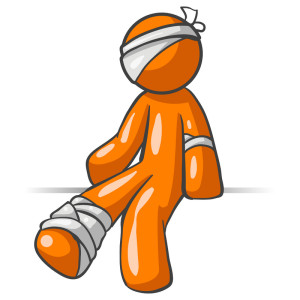 The article goes on to say that these injuries do not truly explain the depth or number of sports-related injuries because many go to their family physicians or to sports medicine clinics rather than to the ER. They also don’t truly highlight the number of overuse injuries, “about 25% of which end up being serious,” notes Neeru Jayanthi, a sports medicine physician at Loyola University Medical Center in Chicago. Overuse injuries result from participation in the same sport and performing the same movements too often, too hard or too young of an age with inadequate recovery time. That is the part that is striking in all of this – we are working our kids hard, but are we giving them enough time to recover from that work? Are we the ones that are causing our kids to get hurt?
The article goes on to say that these injuries do not truly explain the depth or number of sports-related injuries because many go to their family physicians or to sports medicine clinics rather than to the ER. They also don’t truly highlight the number of overuse injuries, “about 25% of which end up being serious,” notes Neeru Jayanthi, a sports medicine physician at Loyola University Medical Center in Chicago. Overuse injuries result from participation in the same sport and performing the same movements too often, too hard or too young of an age with inadequate recovery time. That is the part that is striking in all of this – we are working our kids hard, but are we giving them enough time to recover from that work? Are we the ones that are causing our kids to get hurt?
The American Academy of Pediatrics does offer up guidelines to help prevent overtraining/burn-out of our young athletes:
1. Keep workouts interesting, with age-appropriate games and training, to keep practices fun.
2. Take time off from organized or structured sports participation 1 to 2 days per week to allow the body to rest or participate in other activities.
3. Permit longer scheduled breaks from training and competition every 2 to 3 months while focusing on other activities and cross-training to prevent loss of skill or level of conditioning.
4. Focus on wellness and teaching athletes to be in tune with their bodies for cues to slow down or alter their training methods.
We all know that we focus our kids to become successful. We do this because we want our kids to be successful. But why? Is it truly for our children or is it for us? Do we want them to live out their dream? Or is it that we want to live out our dream that we had and were unable to do, but can do it vicariously through our child. Most parents will deny this to the hilt, but I can tell you that most can see which parents are actually doing just that. I think that most parents and coaches in every gym can name the parents that are living vicariously through their child/ren. It is not something hidden, and most are not fooled by it. But really, why is it? Only 0.2% to 0.5% of high school athletes ever make it to any sort of professional level in sports. Knowing there are MILLIONS playing sports, which a very small amount is moving on from there! As parents, we are tasked with assuring the health and well-being of our children. That is one of the most important jobs we have as parents. We are responsible for making sure they don’t work too much.
So what do we do to help prevent injuries? Well one is to offer rest time. Don’t allow your kid to be in the gym 6 days a week, 4 hours a day. It is just plain unhealthy! 5 days a week is recommended for ANY physical activity; if you have only one physical activity that number should be less. Another thing to do (which sounds crazy) is to allow athletes to participate in more than one sport. Studies show that athletes that are involved in more than one sport and less likely to be injured. Why? They are using and working different parts of their bodies and regularly doing different motions and movements, thus strengthening their bodies to do other activities. Athletes that also participate in more than one sport before puberty are more likely to stay involved in sports longer and are more successful at sports and less likely to be injured overall. The stats are good to allow your kids to be in many sports – the myth is to have them “specialize” in one sport. That does not do them any good in the end. I can tell you as a college athlete – my college interview I was asked about every other sport and club I was involved in. Volleyball was the furthest down the list on topics to discuss, even though that is what the scholarship I received was for. They want well-rounded athletes – not “one trick ponies”.
Participation in sports for kids should be for “fun, skill acquisition, safety and sportsmanship.” This should be the emphasis for every organization you explore for your kid. If the emphasis is on “gym goals” and on “winning”, I can just about guarantee you that there will be an overuse injury in the midst for the athletes involved. Yes – we all love winning, but no one learns anything from just winning. The mentality of any organization associated with youth sports should be the four things mentioned:
1. Fun
2. Skills Acquisition
3. Safety
4. Sportsmanship
They are very easy, but often overlooked. I had one parent tell me they went to an organizational meeting for a sport organization they were considering putting their child in, and not once was the word “fun” used. This is something that this parent noticed right away, and because of that went elsewhere for their child to participate in sports. They ended up paying MORE for their child to participate in an organization that had an objective as having fun. That is truly looking out for your kid.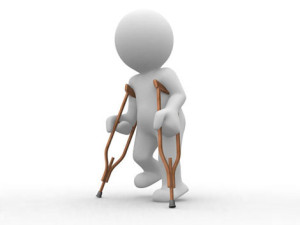
I am guilty of focusing on doing it right. I am too focused on my child using all of her abilities to do what I want her to do. I try to be careful, but I find it difficult to do that. I also drive my child crazy with the question each year – “Do you want to do this?” I ask because I don’t want to assume that she wants to do it and then end up wrong.
This year my child is going through a bit of burn-out. She is having a hard time getting back into the gym. This year was different for her gym because it was the first year that she did not have the summer “off” because of choreography. This in the past was what the deal was – she cheered until May then was off until the start of August. This year she was done in May, and started back at the end of June with clinics and practices in July to ready for Choreography in mid-July. She has been fighting things, but each time we let her step back, she talks about going to cheer and practicing. So we continue to fight with her to get her to do the practices, because she loves the competitions and all that is involved. Her doctor and her psychologist (she has ADHD) both have informed us to not allow her to quit because she doesn’t truly want to. It is a confusing cycle, but we are trying to find the happy medium in it all.
Now, before I am strung up by coaches and gym owners all over the nation about the statements in here – if your athletes attend PRACTICES AS SCHEDULED, there is not an issue. If your athletes take privates in MODERATION, there is not an issue. If you “suggest” that athletes take 3 to 4 privates a week AND have to do additional tumbling classes AND call mandatory practices additionally at random, there IS an issue. The well-being of the KIDS is the first priority, and it is up to the parents to enforce it. Partner with them to insure they can do that safely and without threat of guilt or shame. Remember – while they are your “customers” and paying your bills, they are not going to go pro in the sport of cheer. A majority of them will do something else entirely with their lives. Guilting their parents into believing that they have to work so much to the point of injury will also have an effect on your bottom line.
Ultimately that is the job for all us parents and coaches – finding the happy medium. Don’t be afraid to say no to your child or to their coach. They should be at mandatory practices, but most gyms only have them twice per week; the rest is elective. Make sure you allow your child to be a child too! It will help them – and you – in the end!!
http://www.heartofcheer.com/gyms/much-much-physically-speaking/http://www.heartofcheer.com/wp-content/uploads/2014/08/How-much-physical-6.jpghttp://www.heartofcheer.com/wp-content/uploads/2014/08/How-much-physical-6-150x150.jpgBlogCheerleadersCoachesEducationExcerciseGymsHealthIndustryParentsinjuries,over use,physical activity,practice,Too Much

